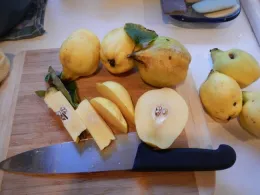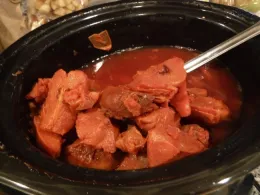
Quince is an easy to grow small tree or shrub. It is drought tolerant and adapts to many soil types but prefers acidic soils. It is self fertile but will produce more fruit with other quince nearby. It needs adequate sunshine for flowers and fruit, it does not require as many winter chill hours as apples. Quince has few pests or diseases.
Quince fruit, when fully ripe has a very floral scent but is very astringent and sour, with a Ph of 3.1. The fruit must be cooked and sugar is vital to making quince palatable. The fruit is also very hard and special care must be taken by the cook with the knife not to injure one's self.
Something magic happens when the white flesh of the quince is slowly cooked with sugar anthocyanins are formed turning the fruit red. Marmalade was originally a quince jam, from the Portuguese word for the fruit marmelo. Because the fruit is very high in pectin it can be made into Spanish Membrillo, a fruit gel, which is traditionally eaten with crusty bread and Manchego cheese. Leave it to the French of Alsace to make a digestif called liqueur de coning from quince fruit.

Spiced Quince in Syrup - Serves 4 (may be scaled up)
2 tablespoons unsalted butter
2 quince (about 1 pound total) peeled and quartered
¼ cup sugar (or more to taste)
1 ½ cup Sauternes
2 green cardamom pods, gently cracked
1 cinnamon stick
1 inch piece fresh ginger, peeled and thinly sliced
1 bay leaf
½ vanilla bean, halved lengthwise
1 cup water
This can be made in a medium pot on the stove but is easier to make in a crock pot.


